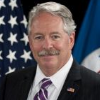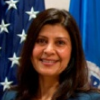Charged with helping guard the nation from terrorist nuclear attack, the Domestic Nuclear Detection Office (DNDO) is responsible for developing high-tech screening systems that can detect a nuclear weapon or “dirty bomb” entering the US through a port, airport or border crossing. DNDO does not manufacture such equipment but instead funds research-and-development and tests and evaluates radiation detection equipment that can be employed by customs officials, border guards and Coast Guard sailors. DNDO’s testing and evaluation of contractor-produced technology has come under fire from government watchdogs and members of Congress for failing to objectively assess expensive detection equipment.
Congress slows Bush effort on nuclear detection office
(by Greta Wodele, Government Executive)
- Systems Architecture Directorate - Examines existing detection equipment to locate any gaps or vulnerabilities that might allow dangerous materials to slip by US officials. The directorate then recommends changes to improve equipment design or use.
- Mission Management Directorate - Manages DNDO programs in key areas, such as ports of entry, airports and border crossings.
- Product Acquisition & Deployment Directorate - Carries out the engineering development, production, developmental logistics procurement and deployment of current and next-generation nuclear detection systems.
- Transformational & Applied Research Directorate - Focuses on long-term research for new detection equipment and systems.
- Operations Support Directorate - Oversees the Joint Analysis Center consisting of personnel from DNDO, the Pentagon, Energy Department, DHS, FBI and NRC, which is on call 24/7 in the event a radiological device is detected at a US harbor, airport or border station. Operations support also provides training to federal, state and local law enforcement and emergency responders on how to handle events involving nuclear weapons or dirty bombs, and it coordinates exercises designed to test those personnel who use detection equipment.
- Systems Engineering & Evaluation Directorate - Ensures that DNDO proposes sound technical solutions prior to deploying new technologies.
- Red Teaming & Net Assessments - Independently assesses the operational performance of planned and deployed detection technologies, procedures and protocols.
- National Technical Nuclear Forensics Center - Established in October 2006 and made up of officials from various federal agencies, this center is responsible for tracing the source of nuclear weapons or dirty bombs found in the US. This includes being able to determine where the radiological material of a bomb (exploded or unexploded) came from.
(PDF)
(PDF)
GAO: Combating Nuclear Smuggling, Additional Actions Needed September 2007
(PDF)
- Table of Contents
- Overview
- History
- What it Does
- Where Does the Money Go
- Controversies
- Suggested Reforms
- Comments
- Leave a comment


On June 20, 2017, President Donald Trump appointed James F. McDonnell III as the director of the Domestic Nuclear Detection Office (DNDO). Located in the Department of Homeland Security (DHS), DNDO is responsible for funding research and development aimed at developing screening systems that can detect a nuclear weapon or “dirty bomb” entering the U.S. McDonnell has been an advisor at DHS since March 2017.
The son of James F. and Barbara McDonnell, he was born circa 1957. His father was a Navy veteran and the president of the J.J. McDonnell Coffee Company.
The younger McDonnell joined the Navy himself in 1975 and retired as an officer twenty years later. He served mainly as an EOD (Explosive Ordnance Disposal)/Special Operations officer. He was posted to Roosevelt Roads, Puerto Rico; Barbers Point, Hawaii; Cecil Field, Florida; and finished up his career at the Naval Special Warfare Development Group in Virginia Beach, Virginia, where he served from 1992 to 1995.
After leaving the Navy, McDonnell served as director of national security operations at Oak Ridge Associated Universities, a consortium of American universities dedicated to advancing scientific research and education, from 1995 to 2001.
Following the September 11, 2001, terrorist attacks, he took a job with the U.S. Department of Energy as the founding director of the Office of Energy Assurance, which was responsible for protecting the nation’s energy infrastructure. In September 2002, McDonnell began working for the Homeland Security Transition Planning Office in the White House, helping to plan the newly created Department of Homeland Security.
At some point, McDonnell gained a B.S. from Regents College (now Excelsior College), a distance learning institution based in Albany, NewYork, that is popular with military personnel. He also earned an M.A. in American Studies at Georgetown University in 2002, where he wrote a thesis entitled, “Constitutional Issues in Federal Management of Domestic Terrorism Incidents,” later published as a short book.
In March 2003, he left both his Energy Department and White House jobs to be division director for critical infrastructure protection at DHS, staying until 2004. He got into a bit of trouble at DHS, however, and was investigated for loose contracting practices, specifically whether he and another DOE official “improperly influenced the decision to give $20 million to the [Oak Ridge National] laboratory since 2004 to help develop a list of the nation's top potential terrorist targets.” No charges were ever brought, although The Washington Post noted that as of October 2006 the list in question “remains incomplete and is of limited value.”
Joining the private sector in June 2004, McDonnell became vice president, chief information & security officer at the U.S. Enrichment Corporation (now Centrus) a nuclear fuel supply company initially created by the Energy Policy Act of 1992. He worked there until December 2006, before briefly working for Amtrak as VP and chief risk officer, in 2007.
In 2005, he was chosen as a senior fellow at George Washington University’s Homeland Security Policy Institute.
McDonnell founded his own consulting firm, McDonnell Consulting Group in Mt. Vernon, Virginia, and was its president from 2004 to March 2017. As such, he provided advice in government relations and business development, as well as counterterrorism, corporate security, and business operations. For most of that time, he was also chairman and CEO of Trinity Applied Strategies Corporation, a commercial risk management company, from May 2006 to December 2015.
Also during those years (October 2014 to December 2016), McDonnell was CEO of I'm Safe Apps, in Fairfax County, Virginia, which sold smartphone and web based security systems that are designed to make average citizens feel safer and more aware of security risks.
Jim McDonnell is married to Deirdre McDonnell.
-Matt Bewig
To Learn More:
LinkedIn Profile
DHS Reviews Claims Of Contract Conflicts (by Spencer S. Hsu, Washington Post)

President Barack Obama appointed Dr. Huban A. Gowadia as director of the Department of Homeland Security’s Domestic Nuclear Detection Office (DNDO) on September 20, 2013, and she was sworn in on December 13. In that role, Gowadia leads the agency responsible for detecting nuclear materials, finding gaps in the nation’s system of detecting nuclear materials and developing technology to detect nuclear materials.
Gowadia was born in 1969 in Mumbai, India. She graduated from the University of Alabama in 1993 with a Bachelor of Science in aerospace engineering. She went on to earn a Ph.D. in mechanical engineering from Pennsylvania State in 2000. She specialized in fluid mechanics and heat and mass transfer. Her dissertation research dealt with “the scientific background for an explosives detection portal for personnel screening.”
She worked for the Federal Aviation Administration’s aviation security laboratory from 2000 to 2001 as part of the explosives and weapons detection team. The September 11, 2001, attacks had a profound effect on Gowadia. After being appointed DNDO director, she told Crimson White, the University of Alabama campus newspaper, “I would have to say the most impactful and shaping event of my life was Sept. 11. Right then and there learning curves were steepened at an incredible pace.…I realized the words of good mentors at the time, and teammates, because we had to do very difficult things in very short periods of time.”
Shortly after the attacks, Gowadia moved to the Transportation Security Administration, where she worked until 2003 as checkpoint program manager. She then managed Homeland Security’s Science & Technology Countermeasures Test Beds until 2005, when she joined DNDO.
Gowadia moved quickly up the ladder in that agency, starting as assistant director for assessments. In 2007, she became assistant director of the mission management directorate before becoming deputy director of DNDO in 2010. She took over as acting director of the agency in 2012 before being formally appointed as director in 2013.
-Steve Straehley
The Natural Sampling of Airborne Trace Signals from Explosives Concealed upon the Human
Body (by Huban A. Gowadia and Gary S. Settles (Pennsylvania State University) (pdf)
- Latest News
- D.C. Public Schools will Teach all Second-Graders to Ride a Bike
- New Rule in Germany Limits Sales of Sex-Themed E-Books to 10pm to 6am
- What Happened to the 6-Year-Old Tibetan Boy the Chinese Government Kidnapped 20 Years Ago?
- U.S. Ambassador to Turkey Photoshops his Hair Color to Mock Turkish Mayor
- Mystery Artist Calls Attention to Unfixed Potholes by Drawing Penises around Them
Charged with helping guard the nation from terrorist nuclear attack, the Domestic Nuclear Detection Office (DNDO) is responsible for developing high-tech screening systems that can detect a nuclear weapon or “dirty bomb” entering the US through a port, airport or border crossing. DNDO does not manufacture such equipment but instead funds research-and-development and tests and evaluates radiation detection equipment that can be employed by customs officials, border guards and Coast Guard sailors. DNDO’s testing and evaluation of contractor-produced technology has come under fire from government watchdogs and members of Congress for failing to objectively assess expensive detection equipment.
Congress slows Bush effort on nuclear detection office
(by Greta Wodele, Government Executive)
- Systems Architecture Directorate - Examines existing detection equipment to locate any gaps or vulnerabilities that might allow dangerous materials to slip by US officials. The directorate then recommends changes to improve equipment design or use.
- Mission Management Directorate - Manages DNDO programs in key areas, such as ports of entry, airports and border crossings.
- Product Acquisition & Deployment Directorate - Carries out the engineering development, production, developmental logistics procurement and deployment of current and next-generation nuclear detection systems.
- Transformational & Applied Research Directorate - Focuses on long-term research for new detection equipment and systems.
- Operations Support Directorate - Oversees the Joint Analysis Center consisting of personnel from DNDO, the Pentagon, Energy Department, DHS, FBI and NRC, which is on call 24/7 in the event a radiological device is detected at a US harbor, airport or border station. Operations support also provides training to federal, state and local law enforcement and emergency responders on how to handle events involving nuclear weapons or dirty bombs, and it coordinates exercises designed to test those personnel who use detection equipment.
- Systems Engineering & Evaluation Directorate - Ensures that DNDO proposes sound technical solutions prior to deploying new technologies.
- Red Teaming & Net Assessments - Independently assesses the operational performance of planned and deployed detection technologies, procedures and protocols.
- National Technical Nuclear Forensics Center - Established in October 2006 and made up of officials from various federal agencies, this center is responsible for tracing the source of nuclear weapons or dirty bombs found in the US. This includes being able to determine where the radiological material of a bomb (exploded or unexploded) came from.
(PDF)
(PDF)
GAO: Combating Nuclear Smuggling, Additional Actions Needed September 2007
(PDF)
Comments


On June 20, 2017, President Donald Trump appointed James F. McDonnell III as the director of the Domestic Nuclear Detection Office (DNDO). Located in the Department of Homeland Security (DHS), DNDO is responsible for funding research and development aimed at developing screening systems that can detect a nuclear weapon or “dirty bomb” entering the U.S. McDonnell has been an advisor at DHS since March 2017.
The son of James F. and Barbara McDonnell, he was born circa 1957. His father was a Navy veteran and the president of the J.J. McDonnell Coffee Company.
The younger McDonnell joined the Navy himself in 1975 and retired as an officer twenty years later. He served mainly as an EOD (Explosive Ordnance Disposal)/Special Operations officer. He was posted to Roosevelt Roads, Puerto Rico; Barbers Point, Hawaii; Cecil Field, Florida; and finished up his career at the Naval Special Warfare Development Group in Virginia Beach, Virginia, where he served from 1992 to 1995.
After leaving the Navy, McDonnell served as director of national security operations at Oak Ridge Associated Universities, a consortium of American universities dedicated to advancing scientific research and education, from 1995 to 2001.
Following the September 11, 2001, terrorist attacks, he took a job with the U.S. Department of Energy as the founding director of the Office of Energy Assurance, which was responsible for protecting the nation’s energy infrastructure. In September 2002, McDonnell began working for the Homeland Security Transition Planning Office in the White House, helping to plan the newly created Department of Homeland Security.
At some point, McDonnell gained a B.S. from Regents College (now Excelsior College), a distance learning institution based in Albany, NewYork, that is popular with military personnel. He also earned an M.A. in American Studies at Georgetown University in 2002, where he wrote a thesis entitled, “Constitutional Issues in Federal Management of Domestic Terrorism Incidents,” later published as a short book.
In March 2003, he left both his Energy Department and White House jobs to be division director for critical infrastructure protection at DHS, staying until 2004. He got into a bit of trouble at DHS, however, and was investigated for loose contracting practices, specifically whether he and another DOE official “improperly influenced the decision to give $20 million to the [Oak Ridge National] laboratory since 2004 to help develop a list of the nation's top potential terrorist targets.” No charges were ever brought, although The Washington Post noted that as of October 2006 the list in question “remains incomplete and is of limited value.”
Joining the private sector in June 2004, McDonnell became vice president, chief information & security officer at the U.S. Enrichment Corporation (now Centrus) a nuclear fuel supply company initially created by the Energy Policy Act of 1992. He worked there until December 2006, before briefly working for Amtrak as VP and chief risk officer, in 2007.
In 2005, he was chosen as a senior fellow at George Washington University’s Homeland Security Policy Institute.
McDonnell founded his own consulting firm, McDonnell Consulting Group in Mt. Vernon, Virginia, and was its president from 2004 to March 2017. As such, he provided advice in government relations and business development, as well as counterterrorism, corporate security, and business operations. For most of that time, he was also chairman and CEO of Trinity Applied Strategies Corporation, a commercial risk management company, from May 2006 to December 2015.
Also during those years (October 2014 to December 2016), McDonnell was CEO of I'm Safe Apps, in Fairfax County, Virginia, which sold smartphone and web based security systems that are designed to make average citizens feel safer and more aware of security risks.
Jim McDonnell is married to Deirdre McDonnell.
-Matt Bewig
To Learn More:
LinkedIn Profile
DHS Reviews Claims Of Contract Conflicts (by Spencer S. Hsu, Washington Post)

President Barack Obama appointed Dr. Huban A. Gowadia as director of the Department of Homeland Security’s Domestic Nuclear Detection Office (DNDO) on September 20, 2013, and she was sworn in on December 13. In that role, Gowadia leads the agency responsible for detecting nuclear materials, finding gaps in the nation’s system of detecting nuclear materials and developing technology to detect nuclear materials.
Gowadia was born in 1969 in Mumbai, India. She graduated from the University of Alabama in 1993 with a Bachelor of Science in aerospace engineering. She went on to earn a Ph.D. in mechanical engineering from Pennsylvania State in 2000. She specialized in fluid mechanics and heat and mass transfer. Her dissertation research dealt with “the scientific background for an explosives detection portal for personnel screening.”
She worked for the Federal Aviation Administration’s aviation security laboratory from 2000 to 2001 as part of the explosives and weapons detection team. The September 11, 2001, attacks had a profound effect on Gowadia. After being appointed DNDO director, she told Crimson White, the University of Alabama campus newspaper, “I would have to say the most impactful and shaping event of my life was Sept. 11. Right then and there learning curves were steepened at an incredible pace.…I realized the words of good mentors at the time, and teammates, because we had to do very difficult things in very short periods of time.”
Shortly after the attacks, Gowadia moved to the Transportation Security Administration, where she worked until 2003 as checkpoint program manager. She then managed Homeland Security’s Science & Technology Countermeasures Test Beds until 2005, when she joined DNDO.
Gowadia moved quickly up the ladder in that agency, starting as assistant director for assessments. In 2007, she became assistant director of the mission management directorate before becoming deputy director of DNDO in 2010. She took over as acting director of the agency in 2012 before being formally appointed as director in 2013.
-Steve Straehley
The Natural Sampling of Airborne Trace Signals from Explosives Concealed upon the Human
Body (by Huban A. Gowadia and Gary S. Settles (Pennsylvania State University) (pdf)
- Latest News
- D.C. Public Schools will Teach all Second-Graders to Ride a Bike
- New Rule in Germany Limits Sales of Sex-Themed E-Books to 10pm to 6am
- What Happened to the 6-Year-Old Tibetan Boy the Chinese Government Kidnapped 20 Years Ago?
- U.S. Ambassador to Turkey Photoshops his Hair Color to Mock Turkish Mayor
- Mystery Artist Calls Attention to Unfixed Potholes by Drawing Penises around Them





Comments